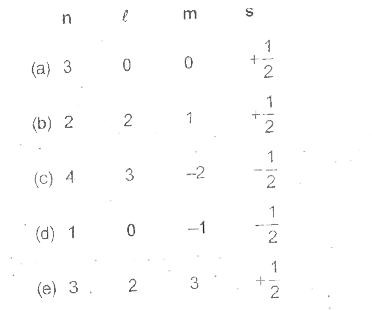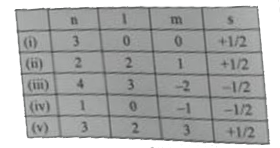Which of the following quantum number is not possible ?
n=3
l=3
m=−1
s=−12
To determine which quantum number is not possible, we need to analyze the given quantum numbers based on the rules governing them. Quantum numbers describe the properties of atomic orbitals and the electrons in those orbitals.
1. Identify the Quantum Numbers:
- The principal quantum number (n)
- The azimuthal quantum number (l)
- The magnetic quantum number (m)
- The spin quantum number (s)
2. Principal Quantum Number (n):
- The principal quantum number (n) can take positive integer values: 1, 2, 3, etc.
- In this case, n = 3 is given, which is valid.
3. Azimuthal Quantum Number (l):
- The azimuthal quantum number (l) can take values from 0 to (n-1).
- For n = 3, l can be 0, 1, or 2.
- If l = 3 is given, this is not possible because l must be less than n.
4. Magnetic Quantum Number (m):
- The magnetic quantum number (m) can take values from -l to +l.
- If l = 2, then m can be -2, -1, 0, +1, +2, which includes all integers between -2 and +2.
- If m = -1 is given, this is valid since it falls within the range.
5. Spin Quantum Number (s):
- The spin quantum number (s) can take values of either +1/2 or -1/2.
- If s is given as either of these values, it is valid.
6. Conclusion:
- The only quantum number that is not possible in this scenario is the azimuthal quantum number (l) being equal to 3 when n = 3.
Final Answer:
The quantum number that is not possible is l = 3.
- The principal quantum number (n)
- The azimuthal quantum number (l)
- The magnetic quantum number (m)
- The spin quantum number (s)
- The principal quantum number (n) can take positive integer values: 1, 2, 3, etc.
- In this case, n = 3 is given, which is valid.
- The azimuthal quantum number (l) can take values from 0 to (n-1).
- For n = 3, l can be 0, 1, or 2.
- If l = 3 is given, this is not possible because l must be less than n.
- The magnetic quantum number (m) can take values from -l to +l.
- If l = 2, then m can be -2, -1, 0, +1, +2, which includes all integers between -2 and +2.
- If m = -1 is given, this is valid since it falls within the range.
- The spin quantum number (s) can take values of either +1/2 or -1/2.
- If s is given as either of these values, it is valid.
- The only quantum number that is not possible in this scenario is the azimuthal quantum number (l) being equal to 3 when n = 3.
The quantum number that is not possible is l = 3.
Topper's Solved these Questions
Similar Questions
Knowledge Check
Which of the following set of quantum number is possible ?
An=4 , l=2, m=-2 ,s=-2Bn=4,l=4,m=0,s=12Cn=4,l=3,m=−3,s=12Dn=4,l=0,m=0,s=0Which of the following set of quantum numbers is not possible ?
An=3,l=0,m=0Bn=3,l=1,m=−1Cn=2,l=0,m=−1Dn=2,l=1,m=0Which of the following sets of quantum number is not possible
An=4,l=1,m=0,s=+1/2Bn=4,l=3,m=−3,s=−1/2Cn=4,l=−1,m=+2,s=1/2Dn=4,l=1,m=0,s=−1/2
Which of the following sets of quantum number is not possible for an electron?
View SolutionConsider the following sets of quantum number

Which of the following sets of quantum number is not possible ?
View SolutionConsider the following sets of quantum numbers

which of the following sets of quantum number is not possible ?
View SolutionConsider the following sets of quantum number

Which of the following sets of quantum number is not possible?
View SolutionConsider the following sets of quantum number

Which of the following sets of quantum number is not possible?
View Solution
